1976 CHEVROLET MONTE CARLO water
[x] Cancel search: waterPage 67 of 102
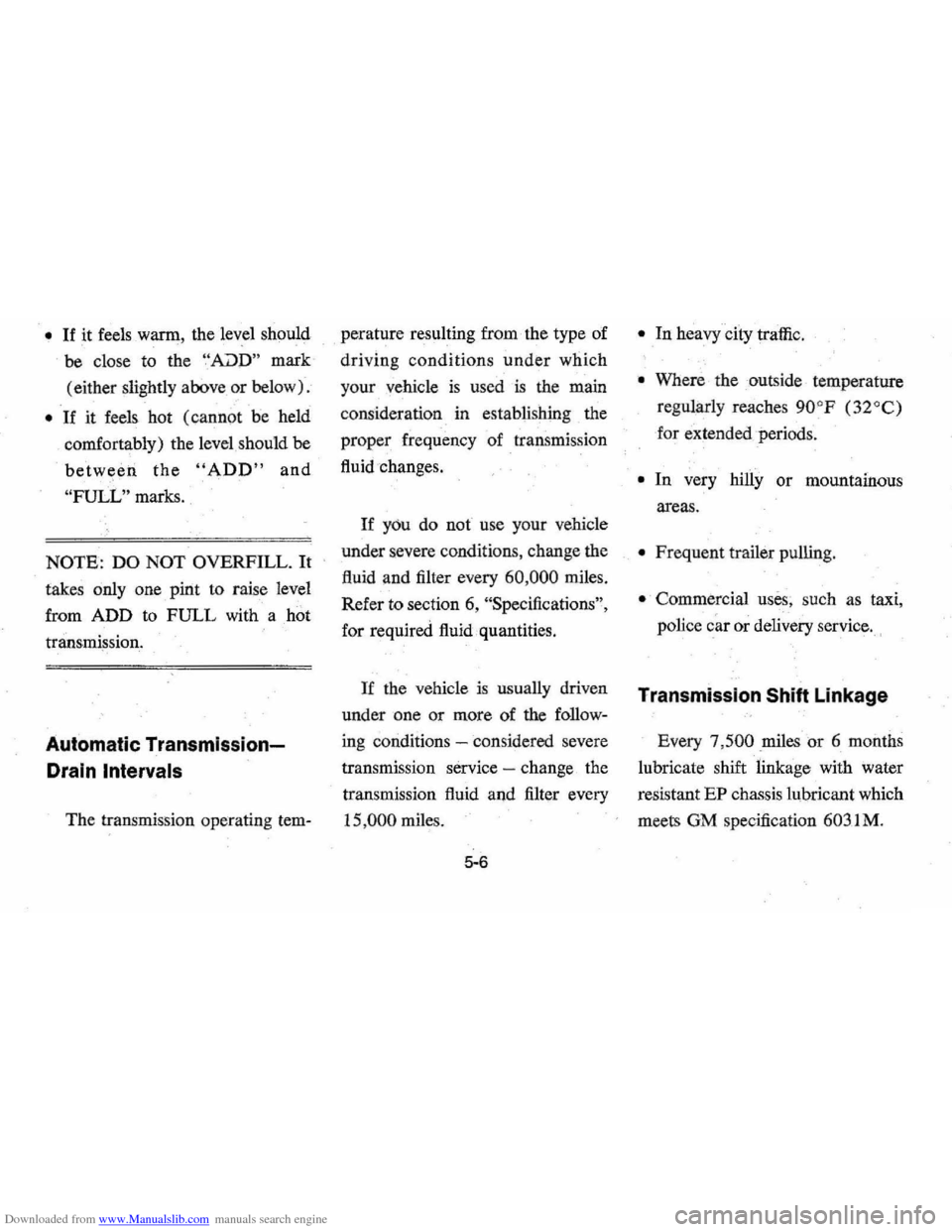
Downloaded from www.Manualslib.com manuals search engine • If it feels warm, the level should
. be close to the "AilD" mark
(either slightly above or below) .
• If it feels hot (cannot be held
comfortably) the level . should be
between the "ADD" and
"FULL" marks.
NOTE: DO NOT OVERFILL. It
takes only one pint to raise level
from ADD to
FULL with a hot
transmission.
Automatic Transmlssion
Drain
Intervals
The transmission operating tem-perature
resulting from the type of
driving
conditions under which
your vehicle
is used is the main
consideration in establi shing the
proper frequency of transmission
fluid changes.
If you do not use your vehicle
under severe conditions, change the
fluid and filter every
60,000 miles.
Refer to section
6, "Specifications",
for required fluid quantities.
If the vehicle is usually driven
under one or more of the follow
ing conditions
-considered severe
transmission service
-change. the
transmission fluid and filter every
15,000 miles.
5-6
• In heavy city traffic .
• Where the outside temperature
regularly reaches 90
0P (32°C)
for extended periods.
• In very hilly or mountainous
areas.
• Frequent trailer pulling .
• Commercial uses, such as taxi,
police
car or delivery service.
Transmission Shift Linkage
Every 7,500 miles or 6 months
lubric ate shift linkage with water
resistant
EP chassis Illbricant which
mee
ts GM specification 6031 M.
Page 68 of 102
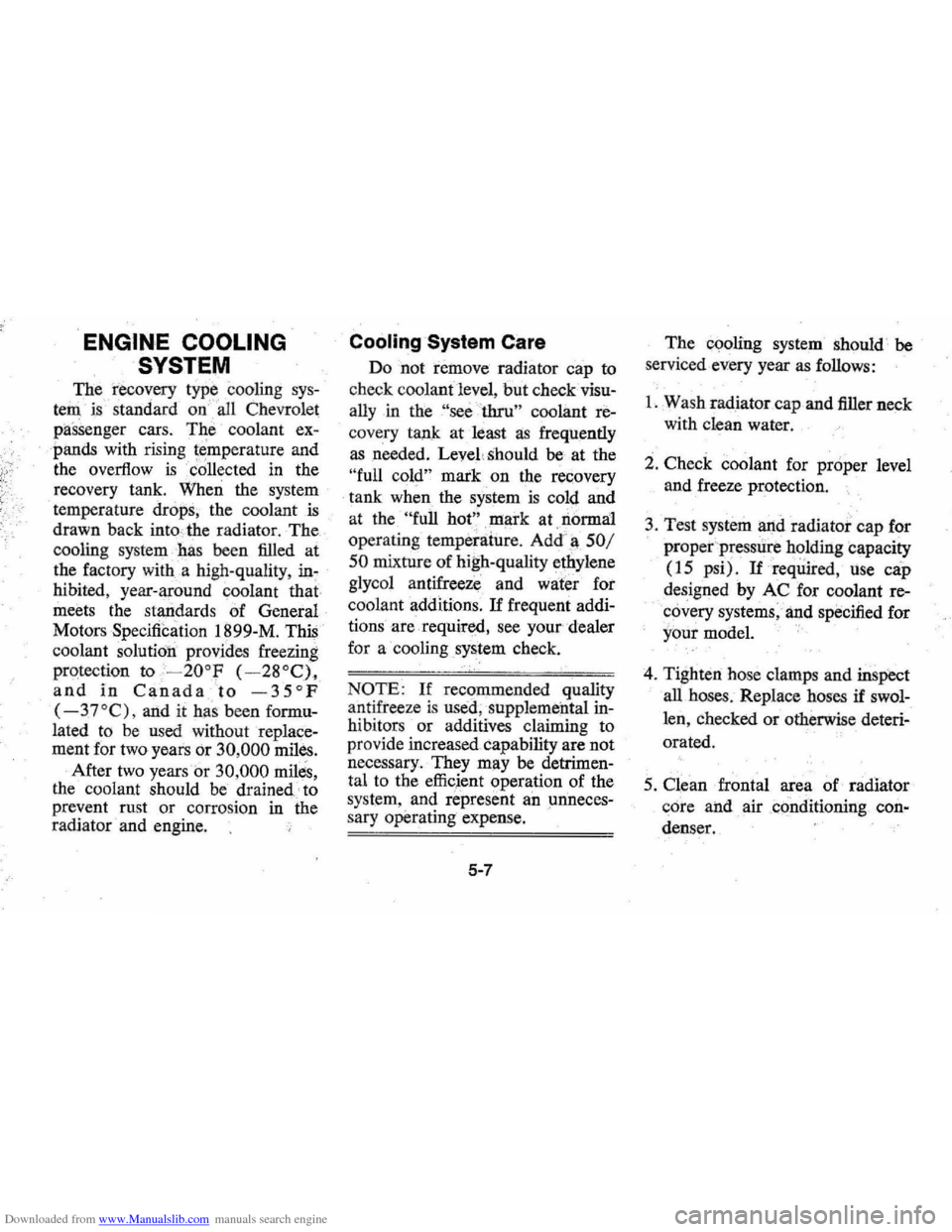
Downloaded from www.Manualslib.com manuals search engine ENGINE COOLING
SYSTEM
The recovery type cooling sys
tem is standard on all Chevrolet
pasSenger cars. The coolant ex~
pands with rising temperature and
the overflow
is dOllected in the
recovery tank.
When the system
temperature drops, the coolant is
drawn back
intocthe radiator. The
cooling system has been filled at
the factory with a high-quality, in
hibited , year-around coolant that
meets the standards
of General
Motors Specification I
899"M. This
coolant solution provides freezing
protection
to -20oP (-28°C),
and in Canada to _35°P
( -37°C), and it h~s been formu
lated to be used without replace
ment for two years or 30,000 miles.
After two years
or 30,000 miles,
the coolant should be drained to
prevent rust or corrosion in the
radiator and engine.
Cooling System Care
Do not remove radiator cap to
check coolantlevel , but
checkvisu
ally in the "see 'thru " coolant re
covery tank at least as frequently
as ,needed. LeveL should be at the
"full cold" mark on the recovery
tank when the system
is cold and
at the
"full hot" roark at Iiormal
operating temperature. Add'~ 501
50 mixture of high-quality ethylene
glycol antifreeze and
waler for
coolant additions.
If frequent addi
tionsare required, see your dealer
for
a cooling system check.
NOTE: If recommended quality
antifreeze
is used,supplemental in
hibitors or additives claiming to
provide increased capability are
not
necessary. They may be detrimen
tal to the efficient operation of the
system, and represent an
unneces
sary operating expense.
5-7
The cooling system should be
serviced every year as follows:
1. Wash radiator cap and filler neck
with clean water.
2. Check coolant for proper level
and freeze protection.
3. Test system
and radiator cap for
, properpresslire holding capacity
(15 psi).
Ifreqitired, use cap
designed by
AC for coolant re
co~ery systems, and specified for
your model.
4, Tighten hose clamps and
inspect
all hoses. Replace hoses if swol
len, checked or otherwise deteri
orated.
5. Clean frontal area of radiator
, qcire and air conditioning con
denser.
Page 69 of 102
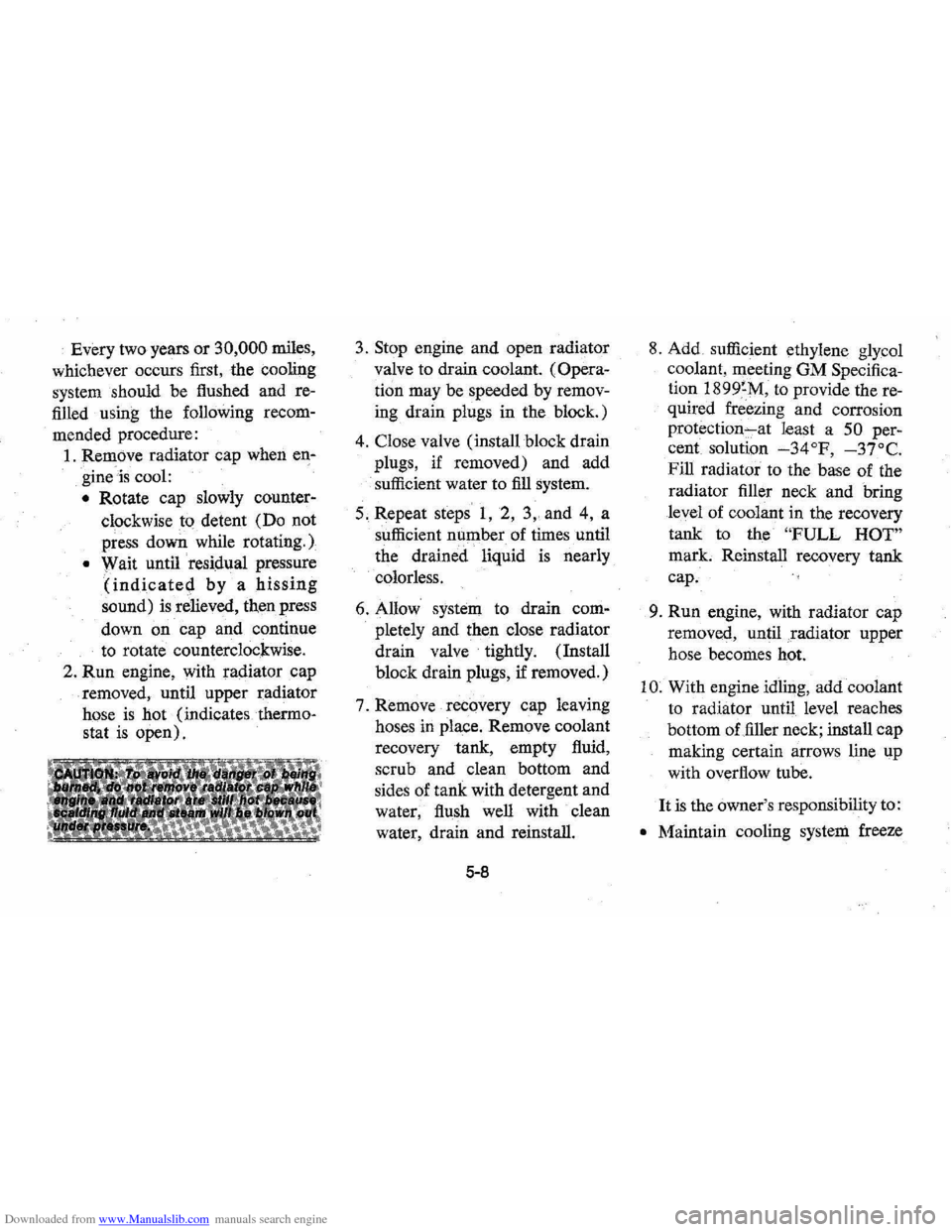
Downloaded from www.Manualslib.com manuals search engine Every two years or 30,000 miles,
whichever occurs first, the cooling
system should be flushed and re
filled using the following recom
mended procedure:
1. Rem()ve radiator cap when en
gineis cool:
• Rotate cap slowly counter
clockwise to detent (Do not
press down while rotating.)
• Wait until residual pressure
(indicated by a hissing
sound) is relieved, then press
down
on cap and continue
to rotate counterclockwise.
2.
Run engine, with radiator cap
removed, until upper radiator
hose
is hot (indicates thermo
stat
is open).
3. Stop engine and open radiator
valve to drain coolant.
(Opera
tion may be speeded by remov
ing drain plugs in the block.)
4. Close valve (install block drain
plugs, if removed) and add
sufficient water to
fill system.
5. Repeat steps
1, 2, 3" and 4, a
sufficient number of times until
the drained liquid
is nearly
colorless.
6. Allow system to drain com
pletely
and then close radiator
drain valve tightly. (Install
block drain plugs, if removed.)
7. Remove recovery cap leaving
hoses in place. Remove coolant
recovery tank, empty fluid,
scrub
and clean bottom and
sides of tank with detergent and
water, flush well with clean
water, drain
and reinstall.
5-8
8. Add sufficient ethylene glycol
coolant, meeting
OM Specifica
tion
1899~M, to provide the re
quired freezing
and corrosion
protection"-at least a 50 per
cent solution
-34°F, -37°C.
Fill radiator to the base of the
radiator filler neck
and bring
level of coolant in the recovery
tank to the
"FULL HOT"
mark. Reinstall recovery tank
cap.
9.
Run engine, with radiator cap
removed, until .radiator upper
hose becomes hot.
I
O. With engine idlil)g, add coolant
to radiator until level reaches
bottom of filler neck; install
cap
making certain arrows line up
with overflow tube.
It is the owner's responsibility to:
• Maintain cooling system freeze
Page 70 of 102
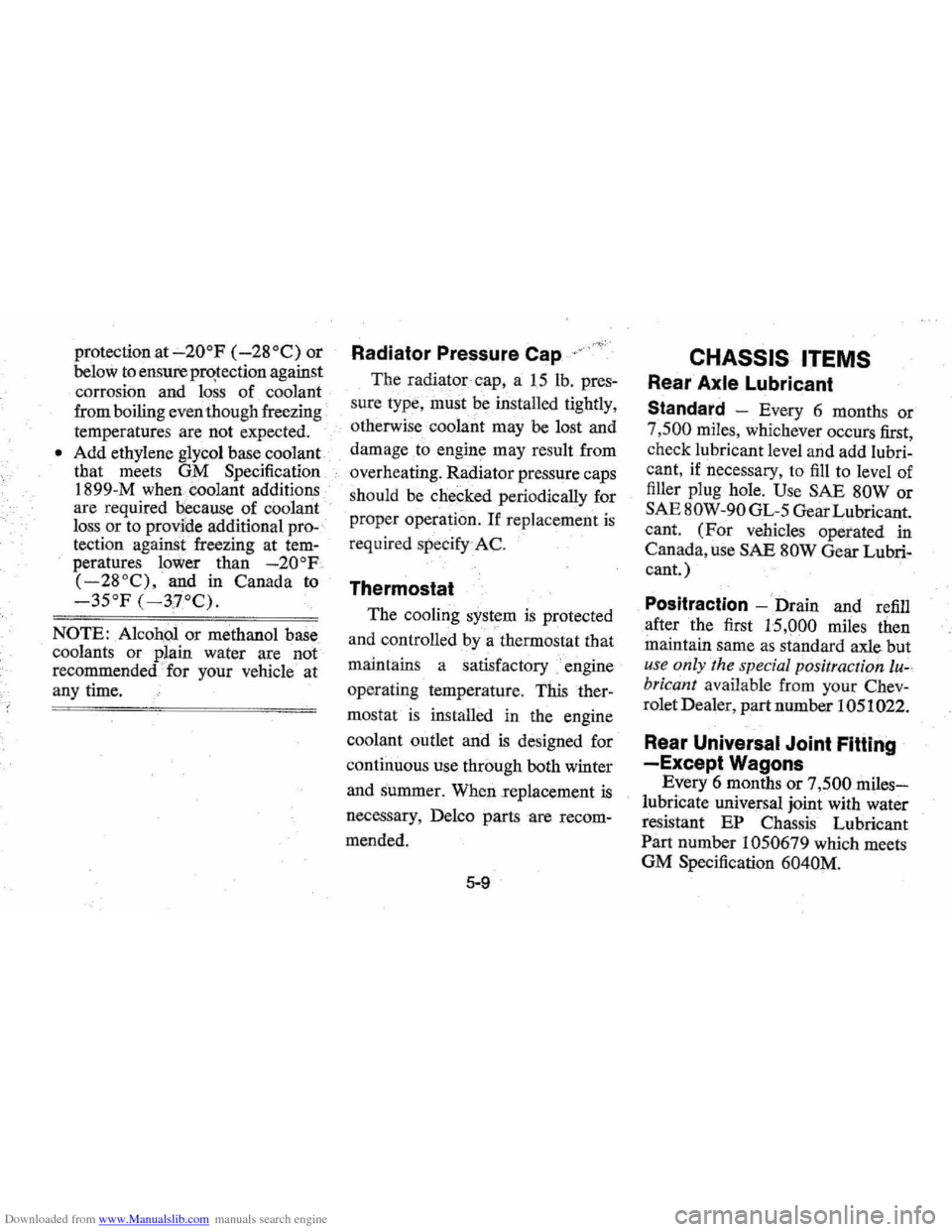
Downloaded from www.Manualslib.com manuals search engine --;
protection at-20op (-2S0C) or
below to ensure pro;tection against
corrosion and loss
of coolant
from boiling even though freezing '
temperatures are not expected.
• Add ethylene glycol base coolant
that meets
GM Specification
IS99-M when coolant additions
are required because of coolant
loss
Or to provide additional pro"
tection against freezing at tem_
peratures lower than _20oP,
(-2S0C),' and in Canada to
_35°P ( -3JOC).
NOTE: AlcOhol Or methanol base
coolants or plain water are not
recommended for your vehicle at
any time.
Radiator Pressure Cap
The radiator cap, a 15 lb. pres
sure type, must be installed tightly,
otherwise coolant may be lost and
damage
, to engine may result from
overheating. Radiator pressure caps
should
be chef'ked periodically for
' proper operation.
If replacement is
required specify·AC.
Thermostat
The cooling system is protected
and controlled by a thermostat that
maintains a satisfactory
" engine
operating temperature . This
ther
mostat is installed in the engine
coolant outlet
arid is designed for
continuous use through both winter
and
s ·ummer. When replacement is
necessary, Delco parts are recom
mended.
5-9
CHASSIS ITEMS
Rear Axle Lubricant
Standard -
Every 6 months or
7,500 miles , whichever occurs first,
check lubricant level and add
lubri
cant, if necessary, to fill to level of
filler plug hole.
Use SAE SOW or
SAE SOW-90 GL-5 Gear Lubricant.
cant.
(Por vehicles operated in
Canada, use
SAE SOW Gear Lubri
cant.)
Posilraction -Drain and refill
after
the first 15,000 miles then
maintain same
as standard axle but
use only the special positraclion lu-·
bricant available from yo ur Chev
roletDealer , part number 1051022.
Rear Universal Joint Fitting
-Except Wagons
Every 6 months or 7,500 miles
lubricate universal joint with water
resistant
EP Chassis Lubricant
Part number 1050679 which meets
GM Specification 6040M.
Page 71 of 102
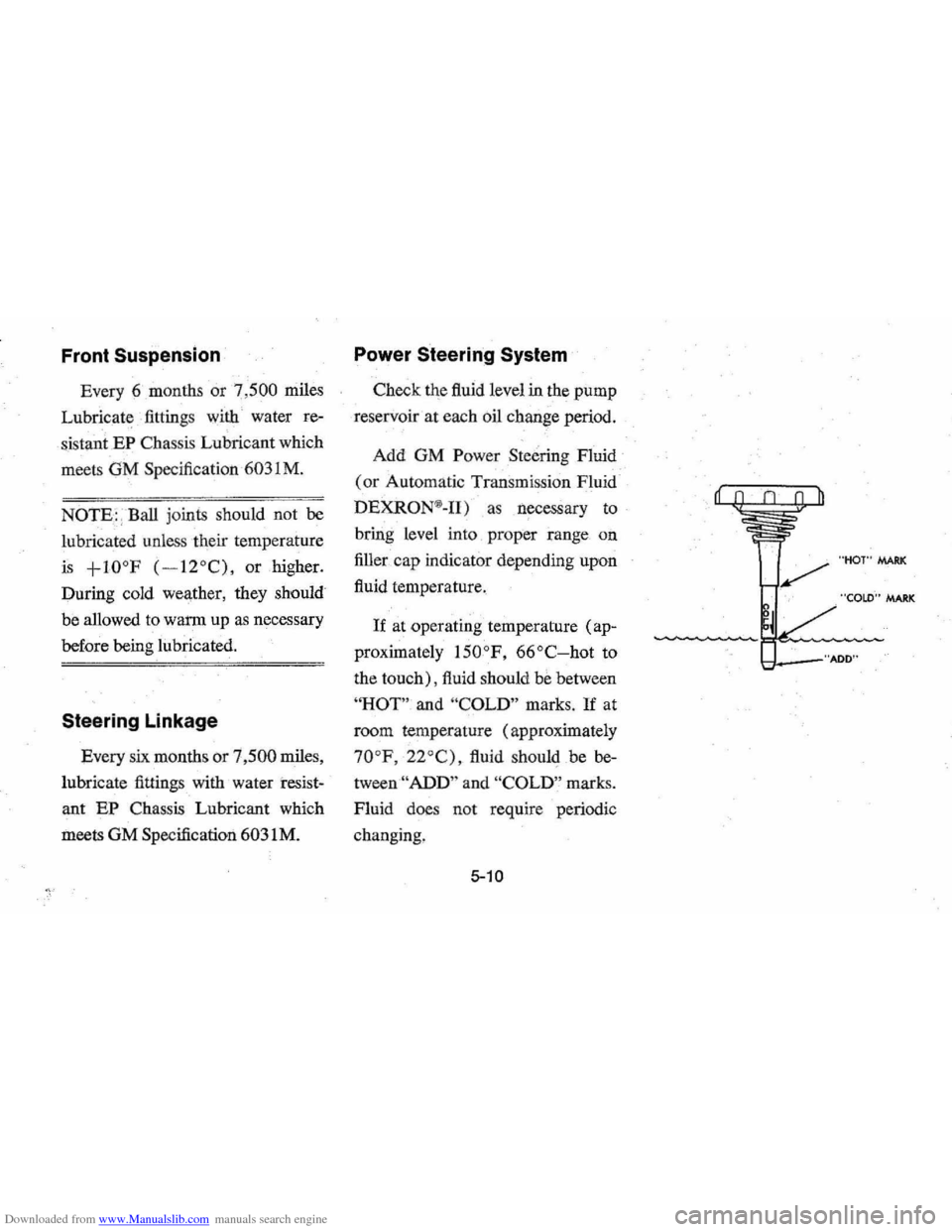
Downloaded from www.Manualslib.com manuals search engine Front suspension
Every 6 months or 7,500 miles
Lubricat~ fittings with water re
sistant EP Chassis Lubricant which
meets
GM Specification6031M.
NOTE: , Ball joints should not be
lubricated unless their temperature
is
+10° F (- 12 °C), or higher.
During cold weather, they should
be allowed to
warm up as necessary
before being
l\lbricated.
Steering Linkage
Every six months or 7,500 miles,
lubri cate fittings with water
resist
ant EP Chassis Lubricant which
meets GM Specification
6031M.
Power Steering System
Check the fluid level in the pump
reservoir at each oil change period.
Add GM
Power Steering Fluid
(or Automatic Transmission Fluid
DEXRON"-II) as necessary to
bririg level into proper range on
filler cap indicator depending upon
fluid temperature.
If at operating temperature (ap
proximately 150°F, 66°C-hot to
the touch), fluid should be between
"HOT" and "COLD" marks. If at
room temperature (approximately
70°F, 22°C), fluid should be be
tween "ADD " and "COLD " marks.
Fluid does not require periodic
changing.
5-10
"HOT" MARK
''COL~'' MARK
\::::j. __ "ADD"
Page 72 of 102
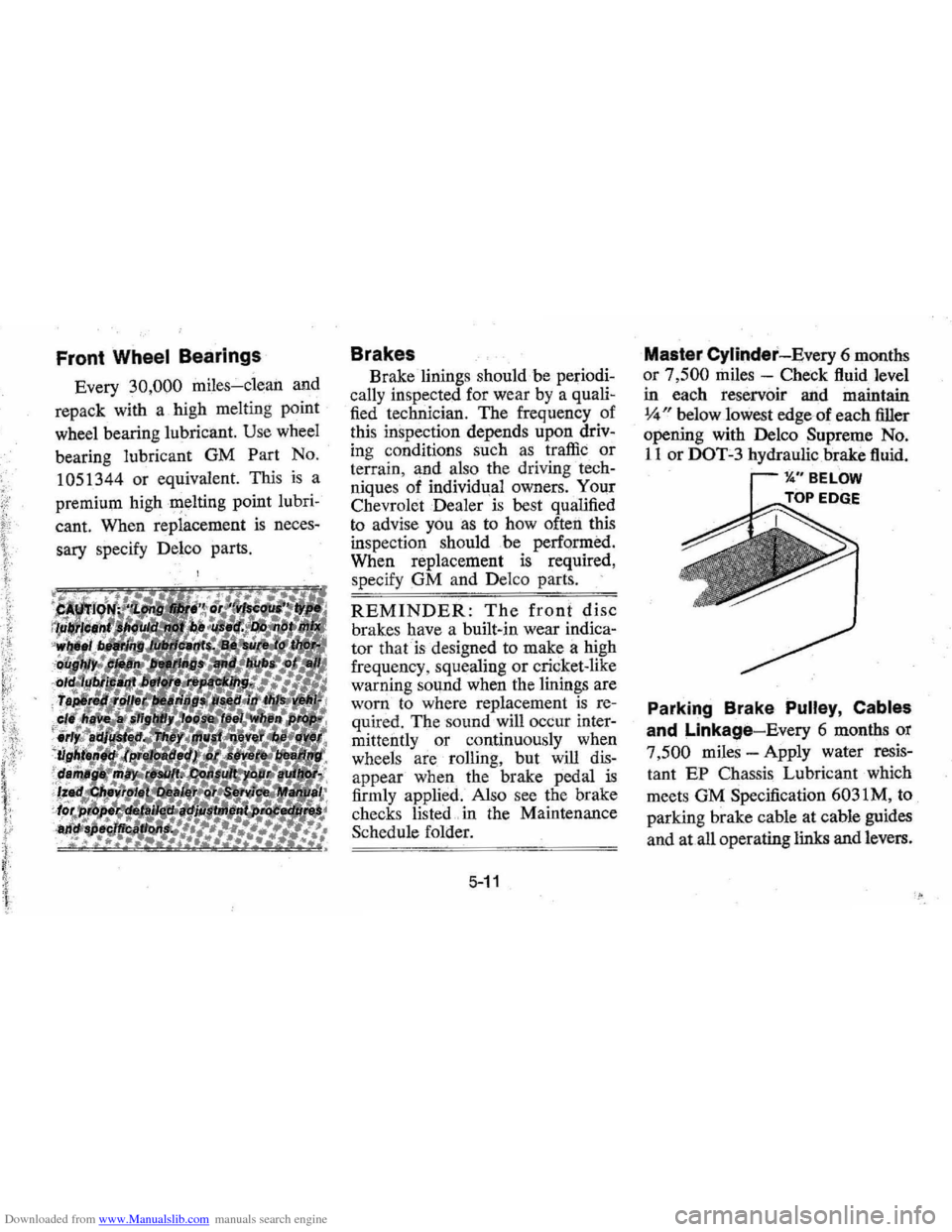
Downloaded from www.Manualslib.com manuals search engine Front Wheel Bearings
Every 30,000 miles-clean and
repack with
a. high melting point
wheel bearing lubricant.
Use wheel
bearing lubricant GM Part No.
1051344 or equivalent. This
is a
premium high
~elting point lubri
cant. When replacement is neces
sary specify Delco parts.
Brakes
Brake linings should be periodi
cally inspected for wear
by a quali
fied technician. The frequency of
this inspection depends upon
driv
ing conditions such as traffic or
terrain, and also the driving tech
niques of individual owners .. Your
Chevrolet Dealer is best qualified
to advise you
as to how often this
inspection should be performed.
When replacement is required,
specify
GM and Delco parts.
REMINDER: The front disc
brakes have a built-in wear indica
tor
thatis designed to make a high
frequency , squealing
or cricket-like
warning
sOl!l1d when the linings are
worn to where replacement is re
quired. The sound will occur inter
mittently or continuously when
wheels are rolling, but will
dis
appear when the brake pedal is
firmly applied. Also see the brake
checks listed. in the Maintenance
Schedule folder.
5-11
Master Cylinder-Every 6 months
or
7,500 miles -Check fluid level
in each reservoir and maintain
14" below lowest edge-of each filler
opening with Delco Supreme No.
liar DOT-3 hydraulic brake fluid.
11." BELOW
TOP EDGE .k:::O"',
Parking Brake Pulley, Cables
and Linkage-Every 6 months or
7
,500 miles -Apply water resis
tant EP Chassis Lubricant which
meets GM Specification 6031M, to
parking brake cahle at cable guides
and at all operating links and levers.
Page 74 of 102
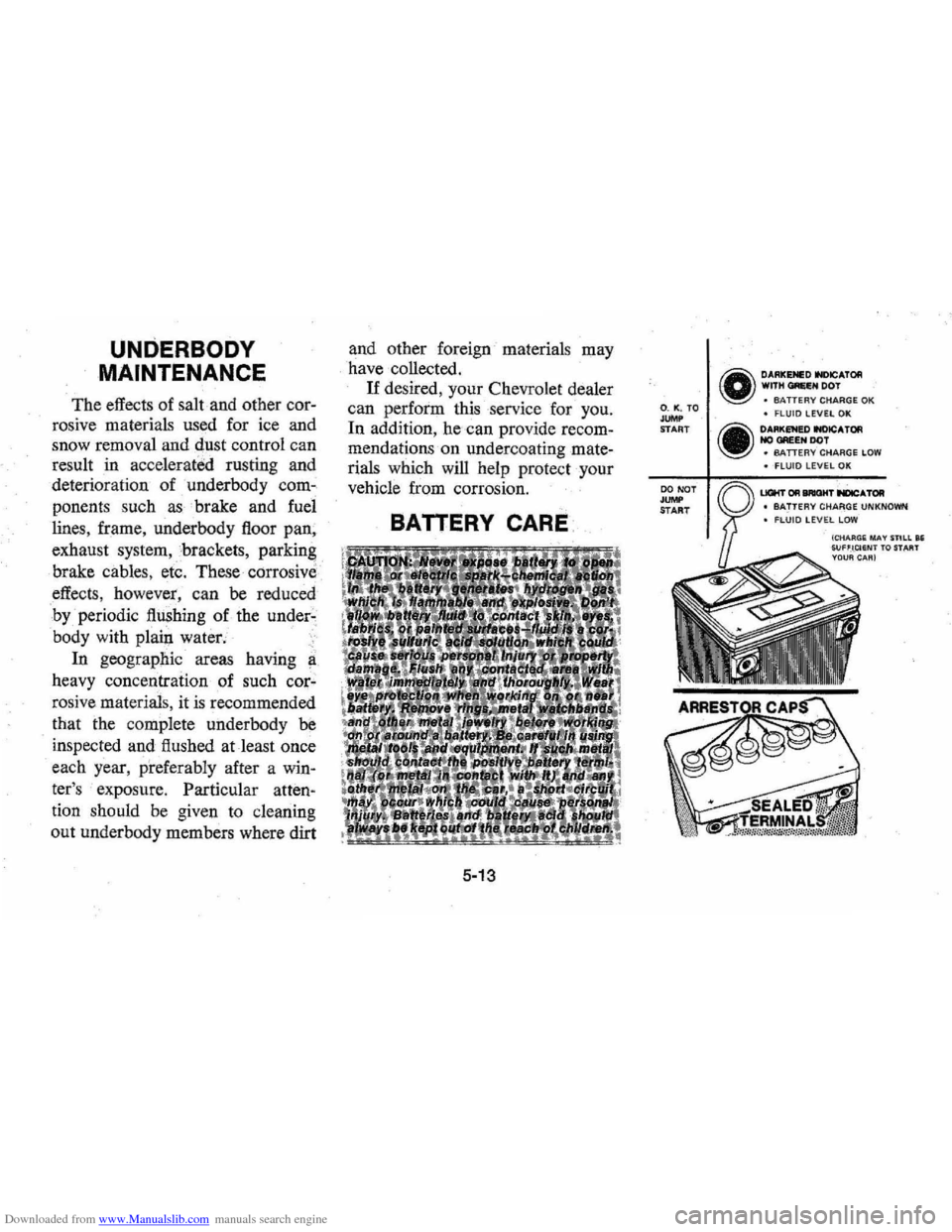
Downloaded from www.Manualslib.com manuals search engine UNDERBODY
MAINTENANCE
The effects of salt and other cor
rosive materials used for ice and
snow removal and
dust control can
result
in accelerated rusting and
deterioration of underbody
com~
ponents such as brake and fuel
lines, frame, underbody floor pan,
exhaust system, ·brackets, parking
brake cables, etc. These
corrosive
effects, however, can be reduced
by periodic flushing of the under- .
body with
plait) water;
In geographic areas having 11
heavy concentration of such COr
rosive materials , it is recommended
that the comple te underbody
be
inspected and flushed at least once
each year, preferably after a
win
ter's exposure. Particular atten
tion should be given to cleaning
out underbody members where dirt and
other foreign materials may
have collected.
If desired, your Chevrolet dealer
can perform this service for you.
In addition, he can provide recom
mendations on under coating mate
rials which will help protect your
vehicle from corrosion.
BA TIERY CARE.
5-13
O. K. TO JUMP START
DO NOT JUMP START
~ DARKENED .. DICATOA WITH GREtH DOT -_ - • BATTERY CHARGE OK • FLUID LEVEL OK
~ OARK9I!.D .. DICATOR NO GAEENDOT _ • BATTERY CHARGE LOW • flUID LEVEL OK
• BATTERY CHARGE UNKNOWN • FLUID LEVEL LOW
{CH ARG& MAV STILL IE SUFfICiENT TO START
Page 79 of 102
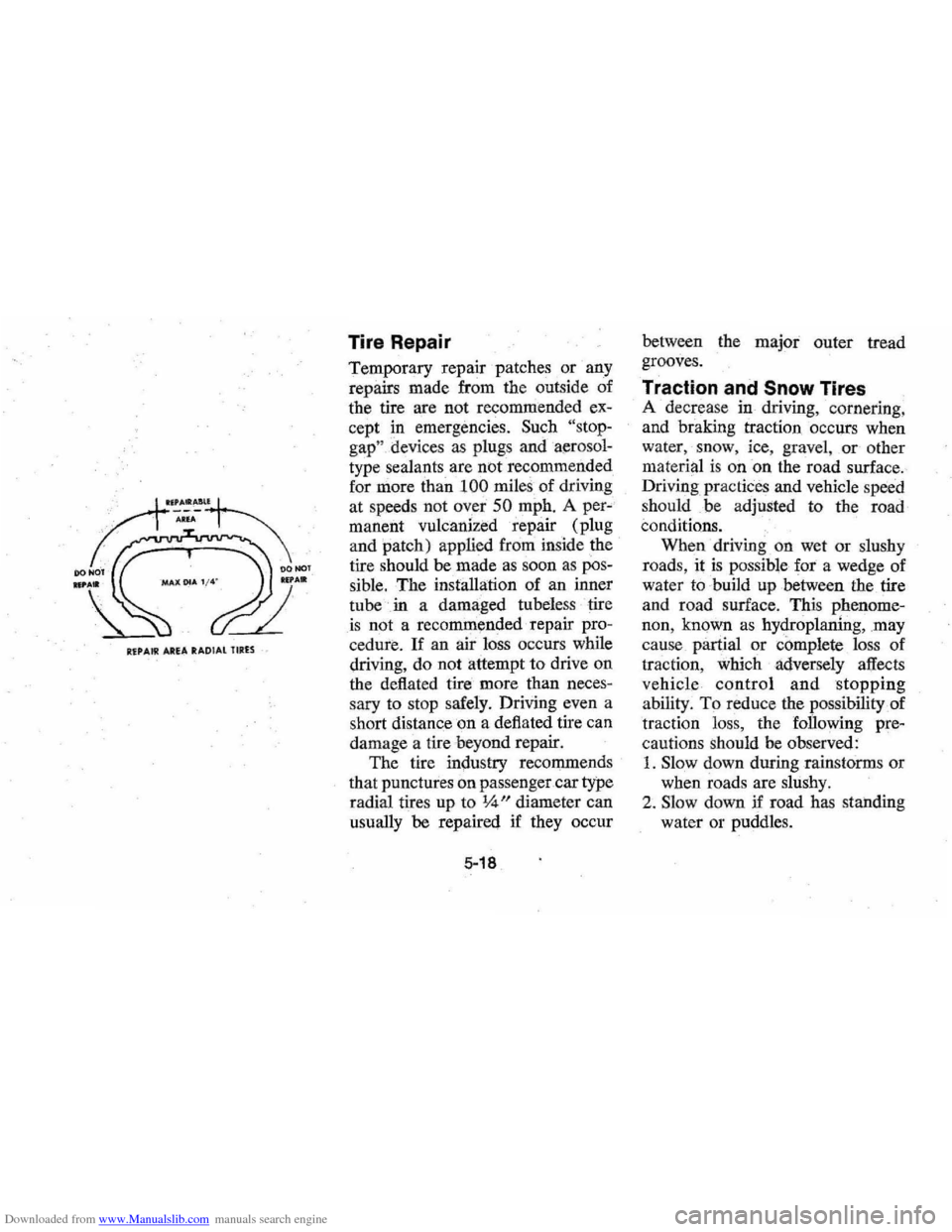
Downloaded from www.Manualslib.com manuals search engine Tire Repair
Temporary repair patches or any
repairs made from the outside of
the tire are not recommended ex
cept
in emergencies. Such "stop
gap" devices as plugs and aerosol
type sealants are not recommended
for more than
100 miles of driving
at speeds not over
50 mph. A per
manent
vulcanized repair (plug
and patch) applied from inside the
tire should be made
as soon as pos
sible. The installation of an inner
tube .
in a damaged tubeless tire
is not a recommended repair pro
cedure.
If an air loss occurs while
driving, do not attempt
to drive on
the deflated tire more than neces
sary to stop safely. Driving even a
short distance on a deflated tire can
damage a tire
-beyond repair.
The tire
in~ustry recommends
that punctures on passenger car type
radial tires up to
\4" diameter can
usually be repaired if they occur
5-18
between the major outer tread
grooves.
Traction and Snow Tires
A decrea se in driving, cornering,
and braking traction occurs when
water, snow , ice~ gravel, _ or other
material is on on the road surface.
Driving practices and vehicle speed
should be adjusted to the road
conditions.
When driving on wet or slushy
roads, it
is possible for a wedge of
water to build up between the tire
and road surface. This phenome
non, known
as hydroplaning, may
cause partial or complete loss of
traction, which adversely
affects
vehicle control and stopping
ability. To reduce the possibility of
traction loss, the
fan owing pre
cautions should be observed:
1. Slow down during rainstorms or
when roads are slushy.
2. Slow down if road has standing
water or puddles.